Brand Management: Brand Building, Portfolio, and Value Assessment
VerifiedAdded on 2024/07/01
|30
|6422
|149
Report
AI Summary
This assignment provides a comprehensive overview of brand management, starting with building and managing brands over time, focusing on brand equity and strategies for strengthening it. It then analyzes brand portfolio and hierarchy management within Procter & Gamble (P&G), examining their brand portfolio strategy and brand equity management. The assignment further evaluates brand extension and leverage, discussing how a selected brand's strengths can be leveraged and its weaknesses addressed, along with potential collaborative agreements. Finally, it assesses techniques for measuring and managing brand value, awareness, market share, consumer attitudes, and buying intentions. This document is contributed by a student and is available on Desklib with other study resources.

Paraphrase This Document
Need a fresh take? Get an instant paraphrase of this document with our AI Paraphraser

Table of Contents
INTRODUCTION..................................................................................................................................... 4
TASK 1 BUILDING AND MANAGING BRAND OVER TIME........................................................................5
TASK 2 BRAND PORTFOLIO AND HIERARCHY MANAGEMENT.............................................................10
TASK 3 BRAND EXTENSION AND LEVERAGE.........................................................................................16
TASK 4 MEASURING AND MANAGING BRAND VALUE.........................................................................24
CONCLUSION.......................................................................................................................................28
REFERENCES........................................................................................................................................ 29
2
INTRODUCTION..................................................................................................................................... 4
TASK 1 BUILDING AND MANAGING BRAND OVER TIME........................................................................5
TASK 2 BRAND PORTFOLIO AND HIERARCHY MANAGEMENT.............................................................10
TASK 3 BRAND EXTENSION AND LEVERAGE.........................................................................................16
TASK 4 MEASURING AND MANAGING BRAND VALUE.........................................................................24
CONCLUSION.......................................................................................................................................28
REFERENCES........................................................................................................................................ 29
2
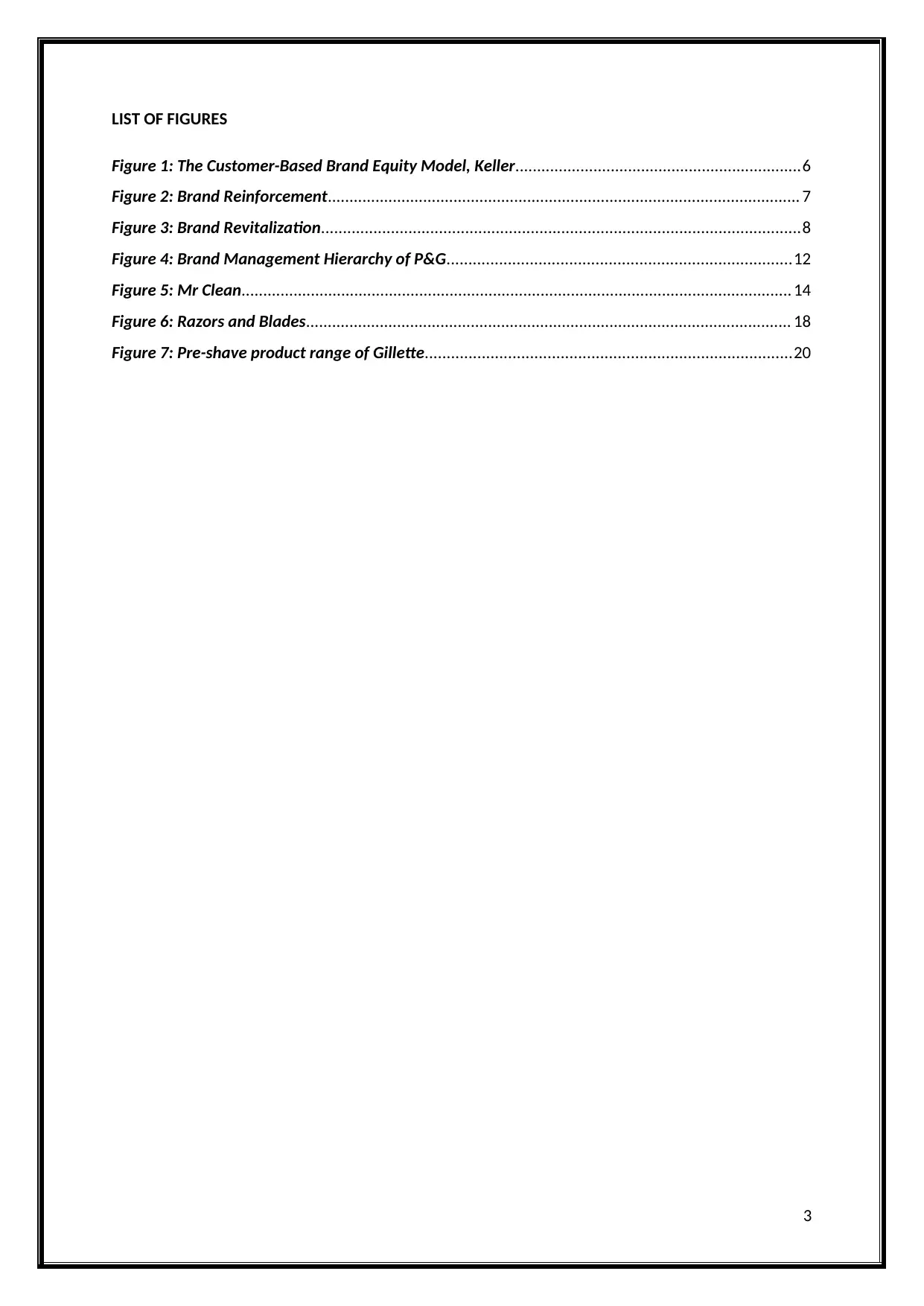
LIST OF FIGURES
Figure 1: The Customer-Based Brand Equity Model, Keller..................................................................6
Figure 2: Brand Reinforcement............................................................................................................. 7
Figure 3: Brand Revitalization..............................................................................................................8
Figure 4: Brand Management Hierarchy of P&G...............................................................................12
Figure 5: Mr Clean............................................................................................................................... 14
Figure 6: Razors and Blades................................................................................................................ 18
Figure 7: Pre-shave product range of Gillette....................................................................................20
3
Figure 1: The Customer-Based Brand Equity Model, Keller..................................................................6
Figure 2: Brand Reinforcement............................................................................................................. 7
Figure 3: Brand Revitalization..............................................................................................................8
Figure 4: Brand Management Hierarchy of P&G...............................................................................12
Figure 5: Mr Clean............................................................................................................................... 14
Figure 6: Razors and Blades................................................................................................................ 18
Figure 7: Pre-shave product range of Gillette....................................................................................20
3
⊘ This is a preview!⊘
Do you want full access?
Subscribe today to unlock all pages.

Trusted by 1+ million students worldwide
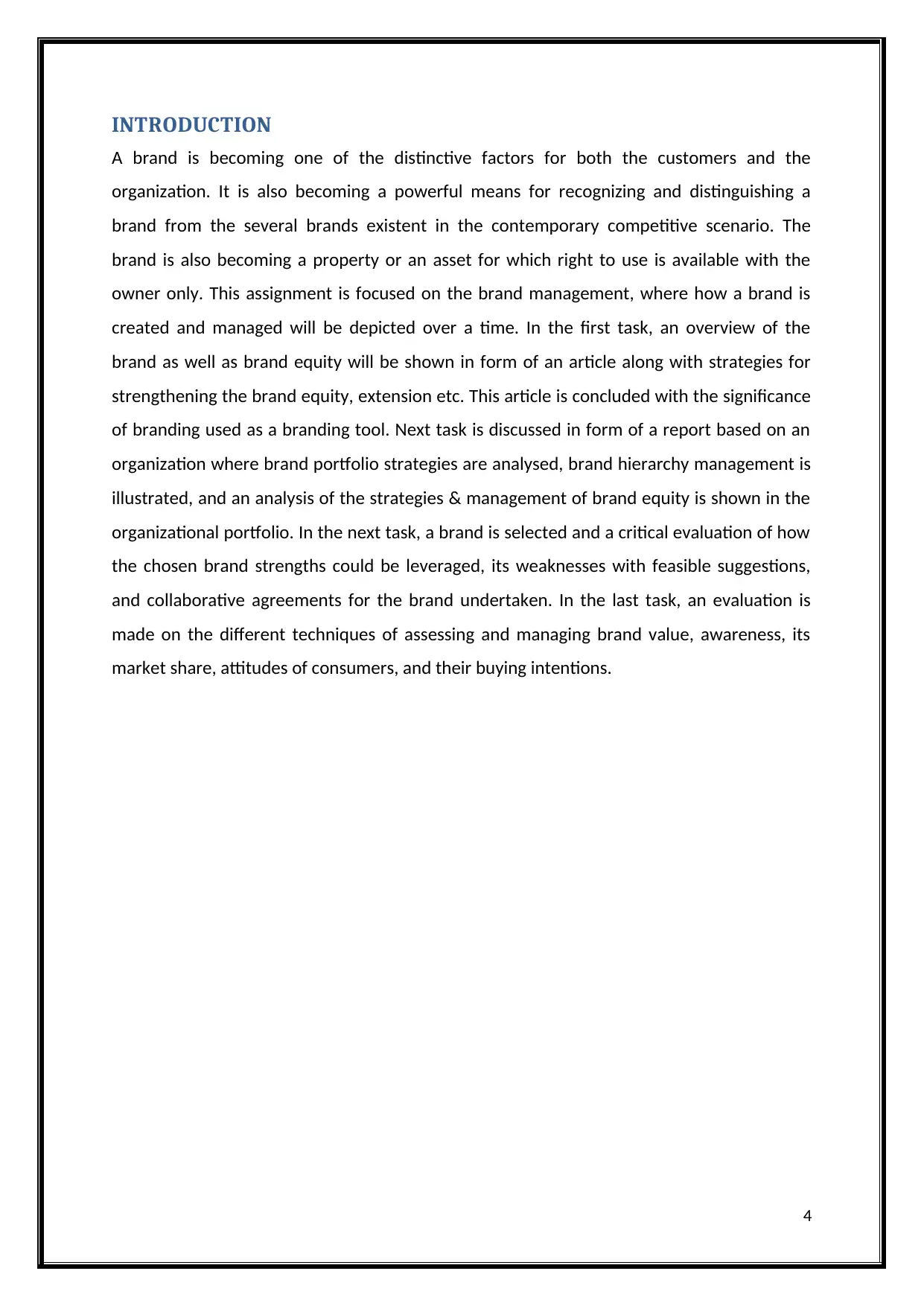
INTRODUCTION
A brand is becoming one of the distinctive factors for both the customers and the
organization. It is also becoming a powerful means for recognizing and distinguishing a
brand from the several brands existent in the contemporary competitive scenario. The
brand is also becoming a property or an asset for which right to use is available with the
owner only. This assignment is focused on the brand management, where how a brand is
created and managed will be depicted over a time. In the first task, an overview of the
brand as well as brand equity will be shown in form of an article along with strategies for
strengthening the brand equity, extension etc. This article is concluded with the significance
of branding used as a branding tool. Next task is discussed in form of a report based on an
organization where brand portfolio strategies are analysed, brand hierarchy management is
illustrated, and an analysis of the strategies & management of brand equity is shown in the
organizational portfolio. In the next task, a brand is selected and a critical evaluation of how
the chosen brand strengths could be leveraged, its weaknesses with feasible suggestions,
and collaborative agreements for the brand undertaken. In the last task, an evaluation is
made on the different techniques of assessing and managing brand value, awareness, its
market share, attitudes of consumers, and their buying intentions.
4
A brand is becoming one of the distinctive factors for both the customers and the
organization. It is also becoming a powerful means for recognizing and distinguishing a
brand from the several brands existent in the contemporary competitive scenario. The
brand is also becoming a property or an asset for which right to use is available with the
owner only. This assignment is focused on the brand management, where how a brand is
created and managed will be depicted over a time. In the first task, an overview of the
brand as well as brand equity will be shown in form of an article along with strategies for
strengthening the brand equity, extension etc. This article is concluded with the significance
of branding used as a branding tool. Next task is discussed in form of a report based on an
organization where brand portfolio strategies are analysed, brand hierarchy management is
illustrated, and an analysis of the strategies & management of brand equity is shown in the
organizational portfolio. In the next task, a brand is selected and a critical evaluation of how
the chosen brand strengths could be leveraged, its weaknesses with feasible suggestions,
and collaborative agreements for the brand undertaken. In the last task, an evaluation is
made on the different techniques of assessing and managing brand value, awareness, its
market share, attitudes of consumers, and their buying intentions.
4
Paraphrase This Document
Need a fresh take? Get an instant paraphrase of this document with our AI Paraphraser

TASK 1 BUILDING AND MANAGING BRAND OVER TIME
BRAND IS POWER
A brand is the identification of a mark, symbol, logo, word, sentence or/and word which is
used by companies for differentiating their products or service from others. The
combination of any one and/or more than one of all these elements could be used for
creating a Brand Identity. A brand is referred to as the company's utmost valued asset. The
brand represents the company's face, the identified logo, a mark or a logo which public
connects with the specific company. Sometimes, the company may be referred to by a
brand and they together become the same.
Brand equity is an additional value which a consumer associates with the brand which is
unique from the rest of the brands present in the market. In different words, brand equity
refers to the customer perception, awareness, and loyalty for a brand. For instance,
additional value paid my customer for Lay’s against any other local chips brand in the
market.
Before settling on a brand to be depicted as a public image, a company needs to first
determine the brand identity or the way the company wants to make it viewed by its
customers. For instance, a company's logo consists of a slogan, message or product which is
offered by the company e.g. logo of Coco-Cola. The main concern is to make a brand
appealing and memorable for the consumer. The visual aspect of a brand is consulted by a
design team or design firm for creating a logo or symbol. A successful brand is what the
company wants to portray to customers and serves in form of brand awareness. When a
brand creates positive opinions among the targeted audience then the company is
considered as if it has built brand equity. Some illustrations of the companies having brand
equity with recognizable brand products are Facebook, Coca-Cola, Apple, Ferrari and
Microsoft.
5
BRAND IS POWER
A brand is the identification of a mark, symbol, logo, word, sentence or/and word which is
used by companies for differentiating their products or service from others. The
combination of any one and/or more than one of all these elements could be used for
creating a Brand Identity. A brand is referred to as the company's utmost valued asset. The
brand represents the company's face, the identified logo, a mark or a logo which public
connects with the specific company. Sometimes, the company may be referred to by a
brand and they together become the same.
Brand equity is an additional value which a consumer associates with the brand which is
unique from the rest of the brands present in the market. In different words, brand equity
refers to the customer perception, awareness, and loyalty for a brand. For instance,
additional value paid my customer for Lay’s against any other local chips brand in the
market.
Before settling on a brand to be depicted as a public image, a company needs to first
determine the brand identity or the way the company wants to make it viewed by its
customers. For instance, a company's logo consists of a slogan, message or product which is
offered by the company e.g. logo of Coco-Cola. The main concern is to make a brand
appealing and memorable for the consumer. The visual aspect of a brand is consulted by a
design team or design firm for creating a logo or symbol. A successful brand is what the
company wants to portray to customers and serves in form of brand awareness. When a
brand creates positive opinions among the targeted audience then the company is
considered as if it has built brand equity. Some illustrations of the companies having brand
equity with recognizable brand products are Facebook, Coca-Cola, Apple, Ferrari and
Microsoft.
5
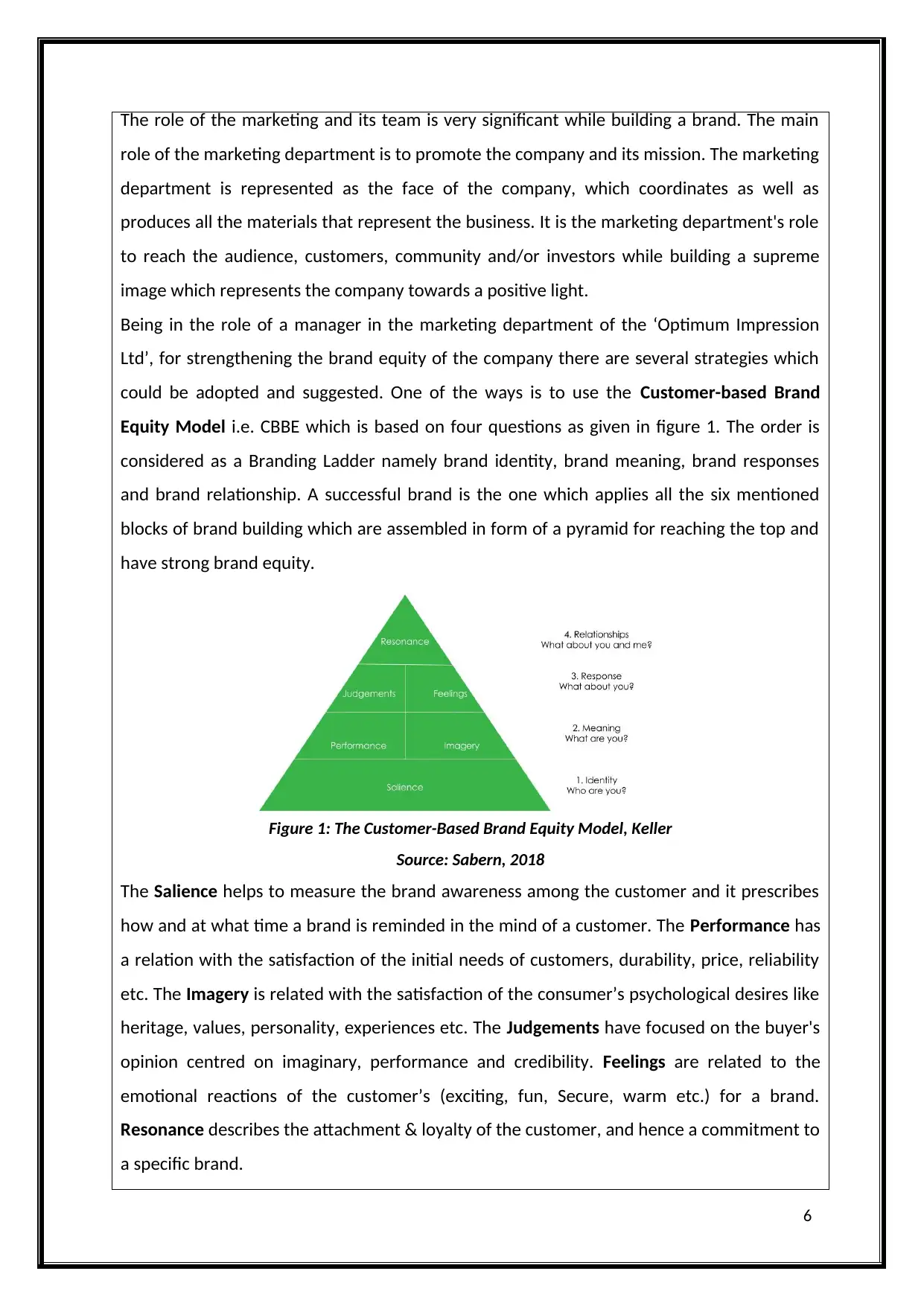
The role of the marketing and its team is very significant while building a brand. The main
role of the marketing department is to promote the company and its mission. The marketing
department is represented as the face of the company, which coordinates as well as
produces all the materials that represent the business. It is the marketing department's role
to reach the audience, customers, community and/or investors while building a supreme
image which represents the company towards a positive light.
Being in the role of a manager in the marketing department of the ‘Optimum Impression
Ltd’, for strengthening the brand equity of the company there are several strategies which
could be adopted and suggested. One of the ways is to use the Customer-based Brand
Equity Model i.e. CBBE which is based on four questions as given in figure 1. The order is
considered as a Branding Ladder namely brand identity, brand meaning, brand responses
and brand relationship. A successful brand is the one which applies all the six mentioned
blocks of brand building which are assembled in form of a pyramid for reaching the top and
have strong brand equity.
Figure 1: The Customer-Based Brand Equity Model, Keller
Source: Sabern, 2018
The Salience helps to measure the brand awareness among the customer and it prescribes
how and at what time a brand is reminded in the mind of a customer. The Performance has
a relation with the satisfaction of the initial needs of customers, durability, price, reliability
etc. The Imagery is related with the satisfaction of the consumer’s psychological desires like
heritage, values, personality, experiences etc. The Judgements have focused on the buyer's
opinion centred on imaginary, performance and credibility. Feelings are related to the
emotional reactions of the customer’s (exciting, fun, Secure, warm etc.) for a brand.
Resonance describes the attachment & loyalty of the customer, and hence a commitment to
a specific brand.
6
role of the marketing department is to promote the company and its mission. The marketing
department is represented as the face of the company, which coordinates as well as
produces all the materials that represent the business. It is the marketing department's role
to reach the audience, customers, community and/or investors while building a supreme
image which represents the company towards a positive light.
Being in the role of a manager in the marketing department of the ‘Optimum Impression
Ltd’, for strengthening the brand equity of the company there are several strategies which
could be adopted and suggested. One of the ways is to use the Customer-based Brand
Equity Model i.e. CBBE which is based on four questions as given in figure 1. The order is
considered as a Branding Ladder namely brand identity, brand meaning, brand responses
and brand relationship. A successful brand is the one which applies all the six mentioned
blocks of brand building which are assembled in form of a pyramid for reaching the top and
have strong brand equity.
Figure 1: The Customer-Based Brand Equity Model, Keller
Source: Sabern, 2018
The Salience helps to measure the brand awareness among the customer and it prescribes
how and at what time a brand is reminded in the mind of a customer. The Performance has
a relation with the satisfaction of the initial needs of customers, durability, price, reliability
etc. The Imagery is related with the satisfaction of the consumer’s psychological desires like
heritage, values, personality, experiences etc. The Judgements have focused on the buyer's
opinion centred on imaginary, performance and credibility. Feelings are related to the
emotional reactions of the customer’s (exciting, fun, Secure, warm etc.) for a brand.
Resonance describes the attachment & loyalty of the customer, and hence a commitment to
a specific brand.
6
⊘ This is a preview!⊘
Do you want full access?
Subscribe today to unlock all pages.

Trusted by 1+ million students worldwide

For successfully managing brand equity it is necessary to reinforce or revitalize the brands.
Brand equity could be reinforced by various marketing activities which frequently deliver
the connotation of the brand to its customers in relation to what product is being
represented by the brand like what core advantages it delivers or what consumer desires it
satisfies and how brand could make this product more superior and which unique, strong,
and favourable attachments are existent in the consumer’s mind.
Figure 2: Brand Reinforcement
Source: Transtutors, 2018
It is generally seen that brands are reinforced through marketing programs which constantly
communicates products meaning for maintaining the image and awareness of the brand.
Brand reinforcing is dependent on the involvement of the characteristics of the brand
association. The brands which have main associations like product-related qualities or/and
functional advantages, innovation in manufacturing, merchandising and product design, are
essential in improving or maintaining the product brand equity. The brands which have
primary associations with the non-product-related qualities and experiential benefits, user
relevance, imagery usage are essential in enhancing and maintaining brand equity.
The brand reinforcement could be understood the example of NIVEA which is one of the
powerful brand of Europe and has grown from skin care cream brand to skin & personal
care brand with carefully designing and implementing brand extensions which reinforces
the promise of the brand to provide ‘gentle’, ‘caring’ and ’mild’ product.
7
Brand equity could be reinforced by various marketing activities which frequently deliver
the connotation of the brand to its customers in relation to what product is being
represented by the brand like what core advantages it delivers or what consumer desires it
satisfies and how brand could make this product more superior and which unique, strong,
and favourable attachments are existent in the consumer’s mind.
Figure 2: Brand Reinforcement
Source: Transtutors, 2018
It is generally seen that brands are reinforced through marketing programs which constantly
communicates products meaning for maintaining the image and awareness of the brand.
Brand reinforcing is dependent on the involvement of the characteristics of the brand
association. The brands which have main associations like product-related qualities or/and
functional advantages, innovation in manufacturing, merchandising and product design, are
essential in improving or maintaining the product brand equity. The brands which have
primary associations with the non-product-related qualities and experiential benefits, user
relevance, imagery usage are essential in enhancing and maintaining brand equity.
The brand reinforcement could be understood the example of NIVEA which is one of the
powerful brand of Europe and has grown from skin care cream brand to skin & personal
care brand with carefully designing and implementing brand extensions which reinforces
the promise of the brand to provide ‘gentle’, ‘caring’ and ’mild’ product.
7
Paraphrase This Document
Need a fresh take? Get an instant paraphrase of this document with our AI Paraphraser

Brand revitalization is needed when there is a requirement for recapturing the vanished
sources of brand equity or when new sources are established and identified for the brand
equity. For regaining the lost sources of brand equity or gaining the new sources of brand
equity Brand reinvention is needed. The brands like Volkswagen, Burberry and Fiat after
their hard times have turned back with their good brand luck.
Figure 3: Brand Revitalization
Source: Transtutors, 2018
There are a number of probable strategies available or designed for acquiring new
customers and holding the present ones. For enhancing brand equity also needs somewhat
change in the branding strategies over a time. Modifications and adjustments on the
branding strategies or programs may include consolidations of the brand, deletion of a
brand or change in name of the brand.
Branding is required for creating a positive image in the consumer’s mind. It is something
different from just a logo. The business's focus, purpose and image when combined create a
brand. Branding distinguishes a business’s focus and purposes that from others which will
make people call a company. Branding ensures customers are aware of the company's
brand. Branding also helps to gain customer loyalty as they trust the quality of a particular
brand. Branding makes the company’s products popular with the ads on radios, billboards,
television, and other media. Branding makes people pay for the image of a specific brand as
they are associated with the quality and only buy certain brands just for this reason.
When a business distinguishes itself through branding, the marketing also got capabilities to
become more profound so that little efforts are required. Developing a brand needs both
efforts and time but when it is solidified and customers have chances to identify with the
8
sources of brand equity or when new sources are established and identified for the brand
equity. For regaining the lost sources of brand equity or gaining the new sources of brand
equity Brand reinvention is needed. The brands like Volkswagen, Burberry and Fiat after
their hard times have turned back with their good brand luck.
Figure 3: Brand Revitalization
Source: Transtutors, 2018
There are a number of probable strategies available or designed for acquiring new
customers and holding the present ones. For enhancing brand equity also needs somewhat
change in the branding strategies over a time. Modifications and adjustments on the
branding strategies or programs may include consolidations of the brand, deletion of a
brand or change in name of the brand.
Branding is required for creating a positive image in the consumer’s mind. It is something
different from just a logo. The business's focus, purpose and image when combined create a
brand. Branding distinguishes a business’s focus and purposes that from others which will
make people call a company. Branding ensures customers are aware of the company's
brand. Branding also helps to gain customer loyalty as they trust the quality of a particular
brand. Branding makes the company’s products popular with the ads on radios, billboards,
television, and other media. Branding makes people pay for the image of a specific brand as
they are associated with the quality and only buy certain brands just for this reason.
When a business distinguishes itself through branding, the marketing also got capabilities to
become more profound so that little efforts are required. Developing a brand needs both
efforts and time but when it is solidified and customers have chances to identify with the
8

brand, the sales will naturally increase. The marketing need not spend much time on
planning the strategies for marketing for attracting the public.
9
planning the strategies for marketing for attracting the public.
9
⊘ This is a preview!⊘
Do you want full access?
Subscribe today to unlock all pages.

Trusted by 1+ million students worldwide
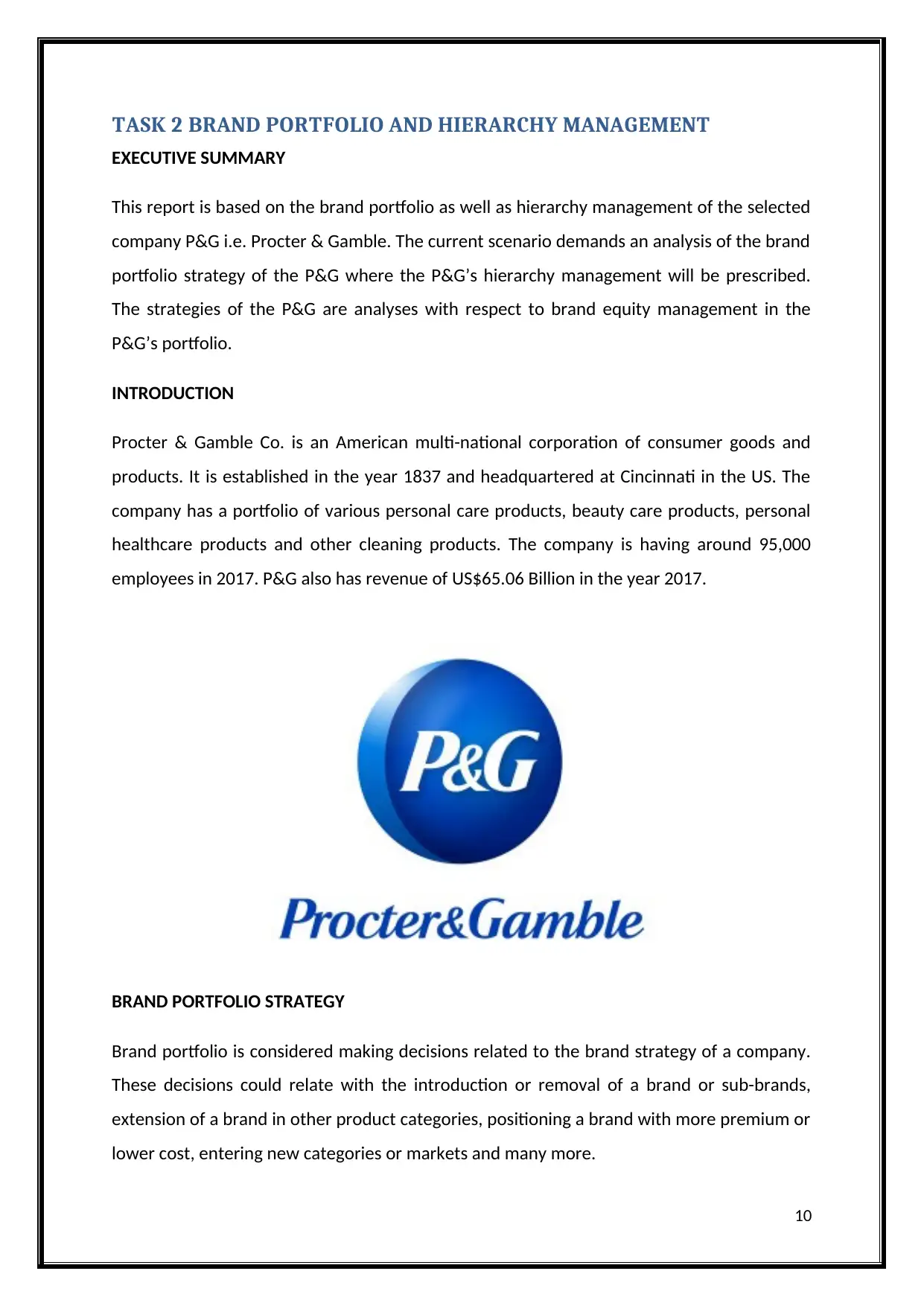
TASK 2 BRAND PORTFOLIO AND HIERARCHY MANAGEMENT
EXECUTIVE SUMMARY
This report is based on the brand portfolio as well as hierarchy management of the selected
company P&G i.e. Procter & Gamble. The current scenario demands an analysis of the brand
portfolio strategy of the P&G where the P&G’s hierarchy management will be prescribed.
The strategies of the P&G are analyses with respect to brand equity management in the
P&G’s portfolio.
INTRODUCTION
Procter & Gamble Co. is an American multi-national corporation of consumer goods and
products. It is established in the year 1837 and headquartered at Cincinnati in the US. The
company has a portfolio of various personal care products, beauty care products, personal
healthcare products and other cleaning products. The company is having around 95,000
employees in 2017. P&G also has revenue of US$65.06 Billion in the year 2017.
BRAND PORTFOLIO STRATEGY
Brand portfolio is considered making decisions related to the brand strategy of a company.
These decisions could relate with the introduction or removal of a brand or sub-brands,
extension of a brand in other product categories, positioning a brand with more premium or
lower cost, entering new categories or markets and many more.
10
EXECUTIVE SUMMARY
This report is based on the brand portfolio as well as hierarchy management of the selected
company P&G i.e. Procter & Gamble. The current scenario demands an analysis of the brand
portfolio strategy of the P&G where the P&G’s hierarchy management will be prescribed.
The strategies of the P&G are analyses with respect to brand equity management in the
P&G’s portfolio.
INTRODUCTION
Procter & Gamble Co. is an American multi-national corporation of consumer goods and
products. It is established in the year 1837 and headquartered at Cincinnati in the US. The
company has a portfolio of various personal care products, beauty care products, personal
healthcare products and other cleaning products. The company is having around 95,000
employees in 2017. P&G also has revenue of US$65.06 Billion in the year 2017.
BRAND PORTFOLIO STRATEGY
Brand portfolio is considered making decisions related to the brand strategy of a company.
These decisions could relate with the introduction or removal of a brand or sub-brands,
extension of a brand in other product categories, positioning a brand with more premium or
lower cost, entering new categories or markets and many more.
10
Paraphrase This Document
Need a fresh take? Get an instant paraphrase of this document with our AI Paraphraser

Brand Portfolio Strategy of P&G
The P&G main concern is to streamline its brand portfolio strategy by developing focus
towards its top brands. The company has announced a plan in the year 2014 for narrowing
the brand portfolio of the P&G, which leads the company to focus on its 60 to 70 major
brands only. The company has withdrawn its support from around 100 brands by selling a
few and shifting away resources from the rest. P&G remains consistent with this strategy or
approach. The company is managing a portfolio of about 10 category-based business units
with around 65 brands under it (P&G, 2016). All these are those categories in which P&G is
having leading positions in the market and categories where the product delivers the
performance differences which matters to consumers.
The P&G’s has adopted the core brand strategy which is focused towards the core category
products of the company, which could be executed by streamlining their product lines. The
company is making smart choices for discarding the unprofitable, commoditized, and
undifferentiated products for providing more differentiated, consumer-preferred, and extra
profitable products in the brand portfolio of the P&G (P&G, 2016).
BRAND MANAGEMENT HIERARCHY WITHIN P&G’S PORTFOLIO
While considering the brand strategy, it is observed that out of two major brand hierarchy
management strategies i.e. Branded House and House of Brands, P&G has adopted for the
House of Brands strategy.
House of Brand Strategy
House of Brand (HOB) is opposite to the Branded House strategy. In House of Brand, sub-
brands are characterised and promoted instead of corporate brand or the company. Many
of the House of Brand businesses are dealing in consumer products or are a type of holding
companies. These businesses procure brands especially the global large brands having
recognized brand equity.
Procter & Gamble Co.
The brand management hierarchy structure of the P&G involves the Global Business Units
(GBUs), Global Business Services (GBS), Corporate functions, and Selling and Market
11
The P&G main concern is to streamline its brand portfolio strategy by developing focus
towards its top brands. The company has announced a plan in the year 2014 for narrowing
the brand portfolio of the P&G, which leads the company to focus on its 60 to 70 major
brands only. The company has withdrawn its support from around 100 brands by selling a
few and shifting away resources from the rest. P&G remains consistent with this strategy or
approach. The company is managing a portfolio of about 10 category-based business units
with around 65 brands under it (P&G, 2016). All these are those categories in which P&G is
having leading positions in the market and categories where the product delivers the
performance differences which matters to consumers.
The P&G’s has adopted the core brand strategy which is focused towards the core category
products of the company, which could be executed by streamlining their product lines. The
company is making smart choices for discarding the unprofitable, commoditized, and
undifferentiated products for providing more differentiated, consumer-preferred, and extra
profitable products in the brand portfolio of the P&G (P&G, 2016).
BRAND MANAGEMENT HIERARCHY WITHIN P&G’S PORTFOLIO
While considering the brand strategy, it is observed that out of two major brand hierarchy
management strategies i.e. Branded House and House of Brands, P&G has adopted for the
House of Brands strategy.
House of Brand Strategy
House of Brand (HOB) is opposite to the Branded House strategy. In House of Brand, sub-
brands are characterised and promoted instead of corporate brand or the company. Many
of the House of Brand businesses are dealing in consumer products or are a type of holding
companies. These businesses procure brands especially the global large brands having
recognized brand equity.
Procter & Gamble Co.
The brand management hierarchy structure of the P&G involves the Global Business Units
(GBUs), Global Business Services (GBS), Corporate functions, and Selling and Market
11
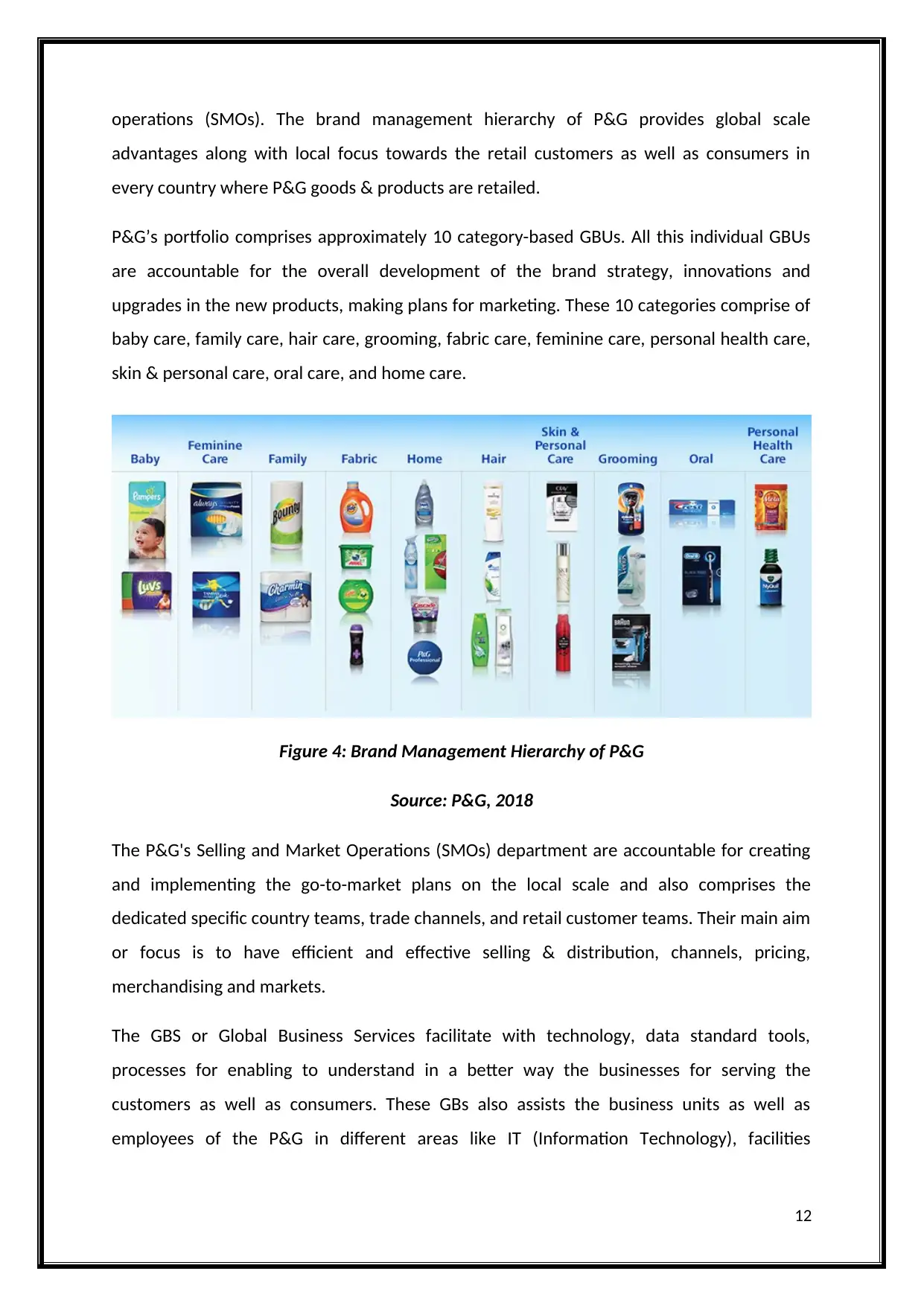
operations (SMOs). The brand management hierarchy of P&G provides global scale
advantages along with local focus towards the retail customers as well as consumers in
every country where P&G goods & products are retailed.
P&G’s portfolio comprises approximately 10 category-based GBUs. All this individual GBUs
are accountable for the overall development of the brand strategy, innovations and
upgrades in the new products, making plans for marketing. These 10 categories comprise of
baby care, family care, hair care, grooming, fabric care, feminine care, personal health care,
skin & personal care, oral care, and home care.
Figure 4: Brand Management Hierarchy of P&G
Source: P&G, 2018
The P&G's Selling and Market Operations (SMOs) department are accountable for creating
and implementing the go-to-market plans on the local scale and also comprises the
dedicated specific country teams, trade channels, and retail customer teams. Their main aim
or focus is to have efficient and effective selling & distribution, channels, pricing,
merchandising and markets.
The GBS or Global Business Services facilitate with technology, data standard tools,
processes for enabling to understand in a better way the businesses for serving the
customers as well as consumers. These GBs also assists the business units as well as
employees of the P&G in different areas like IT (Information Technology), facilities
12
advantages along with local focus towards the retail customers as well as consumers in
every country where P&G goods & products are retailed.
P&G’s portfolio comprises approximately 10 category-based GBUs. All this individual GBUs
are accountable for the overall development of the brand strategy, innovations and
upgrades in the new products, making plans for marketing. These 10 categories comprise of
baby care, family care, hair care, grooming, fabric care, feminine care, personal health care,
skin & personal care, oral care, and home care.
Figure 4: Brand Management Hierarchy of P&G
Source: P&G, 2018
The P&G's Selling and Market Operations (SMOs) department are accountable for creating
and implementing the go-to-market plans on the local scale and also comprises the
dedicated specific country teams, trade channels, and retail customer teams. Their main aim
or focus is to have efficient and effective selling & distribution, channels, pricing,
merchandising and markets.
The GBS or Global Business Services facilitate with technology, data standard tools,
processes for enabling to understand in a better way the businesses for serving the
customers as well as consumers. These GBs also assists the business units as well as
employees of the P&G in different areas like IT (Information Technology), facilities
12
⊘ This is a preview!⊘
Do you want full access?
Subscribe today to unlock all pages.

Trusted by 1+ million students worldwide
1 out of 30
Related Documents
Your All-in-One AI-Powered Toolkit for Academic Success.
+13062052269
info@desklib.com
Available 24*7 on WhatsApp / Email
![[object Object]](/_next/static/media/star-bottom.7253800d.svg)
Unlock your academic potential
Copyright © 2020–2025 A2Z Services. All Rights Reserved. Developed and managed by ZUCOL.


